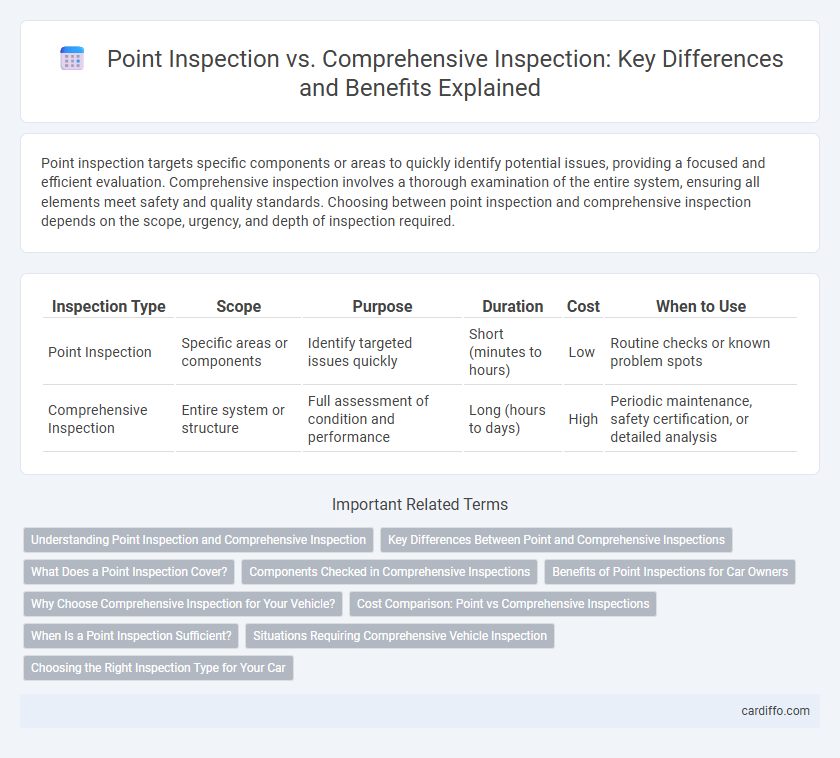Point inspection targets specific components or areas to quickly identify potential issues, providing a focused and efficient evaluation. Comprehensive inspection involves a thorough examination of the entire system, ensuring all elements meet safety and quality standards. Choosing between point inspection and comprehensive inspection depends on the scope, urgency, and depth of inspection required.
Table of Comparison
| Inspection Type | Scope | Purpose | Duration | Cost | When to Use |
|---|---|---|---|---|---|
| Point Inspection | Specific areas or components | Identify targeted issues quickly | Short (minutes to hours) | Low | Routine checks or known problem spots |
| Comprehensive Inspection | Entire system or structure | Full assessment of condition and performance | Long (hours to days) | High | Periodic maintenance, safety certification, or detailed analysis |
Understanding Point Inspection and Comprehensive Inspection
Point inspection targets specific areas or components of a system to identify issues quickly and efficiently, often used for routine maintenance or when a particular problem is suspected. Comprehensive inspection involves a thorough evaluation of the entire system or asset, ensuring all components are assessed for functionality, safety, and compliance, typically performed during major service intervals or pre-purchase evaluations. Understanding the differences enables optimized scheduling and resource allocation, enhancing maintenance accuracy and preventing unexpected failures.
Key Differences Between Point and Comprehensive Inspections
Point inspections focus on specific components or areas, highlighting targeted evaluations such as brake systems or electrical wiring with quicker turnaround times. Comprehensive inspections cover the entire system comprehensively, assessing all mechanical, structural, and safety aspects to ensure overall integrity and compliance with standards. The key difference lies in scope and detail, where point inspections offer focused checks and comprehensive inspections provide exhaustive assessments.
What Does a Point Inspection Cover?
A point inspection focuses on specific components or systems such as brakes, tires, or fluid levels, providing a targeted assessment to identify immediate issues or wear. It typically covers critical safety items like lights, battery condition, and windshield wipers, ensuring the vehicle operates safely and efficiently. This type of inspection is faster and less detailed than a comprehensive inspection, making it ideal for routine maintenance or specific concerns.
Components Checked in Comprehensive Inspections
Comprehensive inspections involve a detailed examination of all critical systems and components, including engine performance, transmission, brake systems, suspension, electrical wiring, and safety features. Unlike point inspections that target specific areas identified by symptoms or routine checks, comprehensive inspections assess overall vehicle health to detect potential failures and wear. This thorough approach ensures that each component meets safety and operational standards, reducing the risk of unexpected breakdowns.
Benefits of Point Inspections for Car Owners
Point inspections offer car owners targeted assessments of critical vehicle components, enabling faster identification and resolution of specific issues while minimizing downtime. This focused approach reduces inspection costs compared to comprehensive inspections, making it an efficient choice for routine maintenance and early problem detection. By prioritizing key areas such as brakes, tires, and fluid levels, point inspections help maintain vehicle safety and performance without the expense of full system evaluations.
Why Choose Comprehensive Inspection for Your Vehicle?
Comprehensive inspection provides an in-depth evaluation covering all major vehicle systems, identifying potential issues before they escalate into costly repairs. Unlike point inspections that focus on specific components or areas, comprehensive inspections ensure safety, reliability, and enhanced performance by thoroughly checking engine, brakes, suspension, and electrical systems. Choosing a comprehensive inspection maximizes vehicle longevity and helps maintain resale value through detailed diagnostics and preventive maintenance.
Cost Comparison: Point vs Comprehensive Inspections
Point inspections generally incur lower costs due to their targeted scope, focusing on specific components or areas, which reduces labor and time expenses. Comprehensive inspections involve a detailed and extensive evaluation of the entire system or facility, leading to higher costs driven by increased labor hours, equipment use, and thorough documentation requirements. Businesses often weigh the cost-benefit ratio, choosing point inspections for routine maintenance and comprehensive inspections for critical assessments or compliance mandates.
When Is a Point Inspection Sufficient?
A point inspection is sufficient when evaluating specific components or localized areas of a property, such as checking electrical outlets or plumbing fixtures during a routine maintenance visit. It targets isolated issues without the need for a full-scale assessment, making it ideal for periodic safety checks or verifying recent repairs. Comprehensive inspections are reserved for thorough evaluations involving multiple systems, typically during property sales or extensive renovations.
Situations Requiring Comprehensive Vehicle Inspection
Situations requiring comprehensive vehicle inspection include post-accident assessments, pre-purchase evaluations, and routine maintenance for high-mileage or older vehicles to ensure overall safety and mechanical integrity. Comprehensive inspections cover all major systems, including engine, transmission, brake, suspension, and electrical components, identifying hidden issues that point inspections may miss. This thorough approach helps prevent unexpected breakdowns and maintains vehicle reliability under demanding conditions.
Choosing the Right Inspection Type for Your Car
Point inspection targets specific components such as brakes, tires, or fluid levels to quickly identify immediate issues, making it ideal for routine maintenance or when you suspect a particular problem. Comprehensive inspection involves a detailed evaluation of the entire vehicle, including engine performance, suspension, electrical systems, and safety features, ensuring a thorough assessment for used car purchases or before long trips. Selecting the right inspection type depends on your car's age, mileage, and any existing concerns, balancing thoroughness with time and cost efficiency.
Point inspection vs Comprehensive inspection Infographic

 cardiffo.com
cardiffo.com